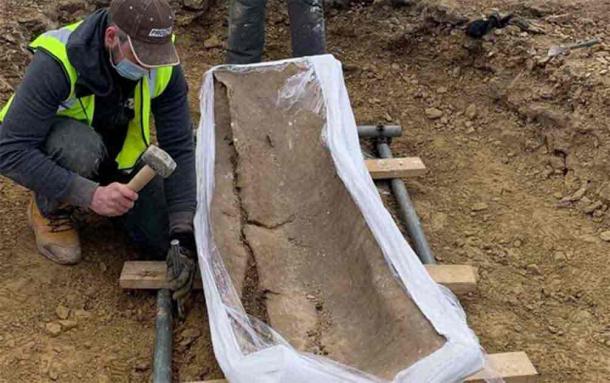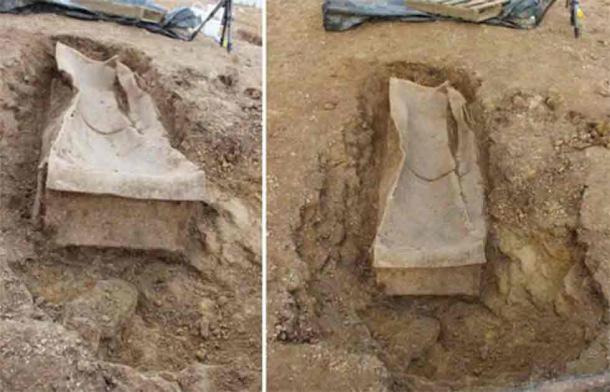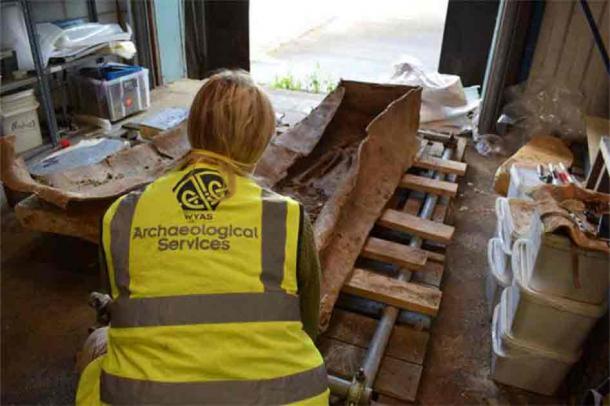🔴 Website 👉 https://u-s-news.com/
Telegram 👉 https://t.me/usnewscom_channel
In an unexpected twist, archaeologists investigating a “truly unique and remarkable” lead coffin from Roman era Britain have identified a set of previously undocumented remains.
Found in 2022, archaeologists hailed the discovery of a hidden cemetery in Garforth, Leeds as a “once-in-a-lifetime find”. The site, dating back 1,600 years, included the remains of a high-status Roman woman encased in a lead coffin, as well as sixty other bodies, including men, women, and twenty-three children.
The pick of the finds were the remains of the late-Roman period aristocratic woman, signified by the lead coffin containing pieces of jewelry, an expensive burial practice and a marker of high social status. Now, examination of the remains has revealed that the bones include that of a child of around 10 years of age.
The news release from Leeds Council stated that whilst it is not possible to say exactly who the child was, or its relationship to the woman, ‘carbon dating of the remains has revealed that their burials took place around the same time, raising intriguing questions about late Roman burial practices in Britain.’
David Hunter, the principal archaeologist with West Yorkshire Joint Services, said, “This has the potential to be a find of massive significance for what we understand about the development of ancient Britain and Yorkshire.”
The lead coffin of the aristocratic Roman woman and child found in Yorkshire, Northern England. (Leeds City Council)
Late Roman and Early Saxon Burials: Transition of Power
The cemetery is believed to include both late Roman and early Saxon burials, with some graves accompanied by personal possessions, such as knives and pottery. The discovery of the cemetery is significant because it may help fill in historical gaps in understanding the Kingdom of Elmet – the huge swathe of land that was later broken down into Yorkshire subdivisions, according to a press release at the time of the discovery.
The ancient lead coffin was unearthed in a previously undiscovered, 1,600-year-old cemetery in Leeds, UK. (Leeds City Council)
Kylie Buxton, the on-site supervisor said it was every archaeologist’s dream to work on such a project, adding:
“There is always a chance of finding burials, but to have discovered a cemetery of such significance, at such a time of transition, was quite unbelievable. For me, it was a particular honor to excavate the high-status lead coffin burial, but it was a great team effort by everyone involved.”
Having been carefully examined, the lead coffin is soon to be displayed as part of the Living With Death exhibition at the Leeds City Museum.
Kat Baxter, for the excavations and Leeds Museums and Galleries’ curator of archaeology, said:
“This is a truly unique and remarkable find which has potentially huge implications for our understanding of the history of early Leeds and those who made their home here.
The discovery of the remains of a second individual within the coffin is fascinating, particularly as they belonged to a child. It poses some interesting questions about how people more than 1,600 years ago treated their dead. The Roman lead coffin itself is also the only one ever discovered in West Yorkshire and the site has provided us with new opportunities to study life and death in ancient Yorkshire.
We’re delighted to be able to display the coffin so quickly after excavation, and we’re looking forward to sharing this amazing piece of history with our visitors.”
Archaeologists who worked on the excavation said the site can help chart the largely undocumented and historically-important transition between the fall of the Roman Empire in about 400 AD and the establishment of the Anglo-Saxon kingdoms that followed. This would include the period of transition, the power vacuum, and the various players involved in the transition of power.
The location of the cemetery was kept confidential at the developer’s request. The excavation was prompted by the previous nearby discovery of late Roman stone buildings and a small number of Anglo-Saxon style structures, reported The Guardian.
The remains of what appears to be a Roman aristocratic woman were inside the lead coffin. (Leeds City Council)
Shared Culture and Historicity?
Archaeologists traced the burial traditions of both Roman and Saxon cultures in the cemetery, which was described as a ‘highly unusual’ practice by Hunter.
“The presence of two communities using the same burial site is highly unusual and whether their use of this graveyard overlapped or not will determine just how significant the find is. When seen together the burials indicate the complexity and precariousness of life during what was a dynamic period in Yorkshire’s history. The lead coffin itself is extremely rare, so this has been a truly extraordinary dig.”
Early Christian beliefs are reflected through the burial practices, along with a Saxon burial, coupled with personal possessions like knives and pottery.
While the exact identities of those buried at the site will never be known, the remains offer an invaluable insight into the lives of people in ancient Britain and Yorkshire.
Living with Death, which is generously sponsored by Co-op Funeralcare, will be at Leeds City Museum from May 3, 2024 until January 5, 2025 and is free to visit.
“We certainly got more than we bargained for,” Hunter told CNN. “But we didn’t expect to find a cemetery of 62 at this location,” he concluded.
Top image: The lead coffin of the aristocratic Roman woman’s burial found in Yorkshire, Northern England. Source: Leeds City Council
By Sahir Pandey



